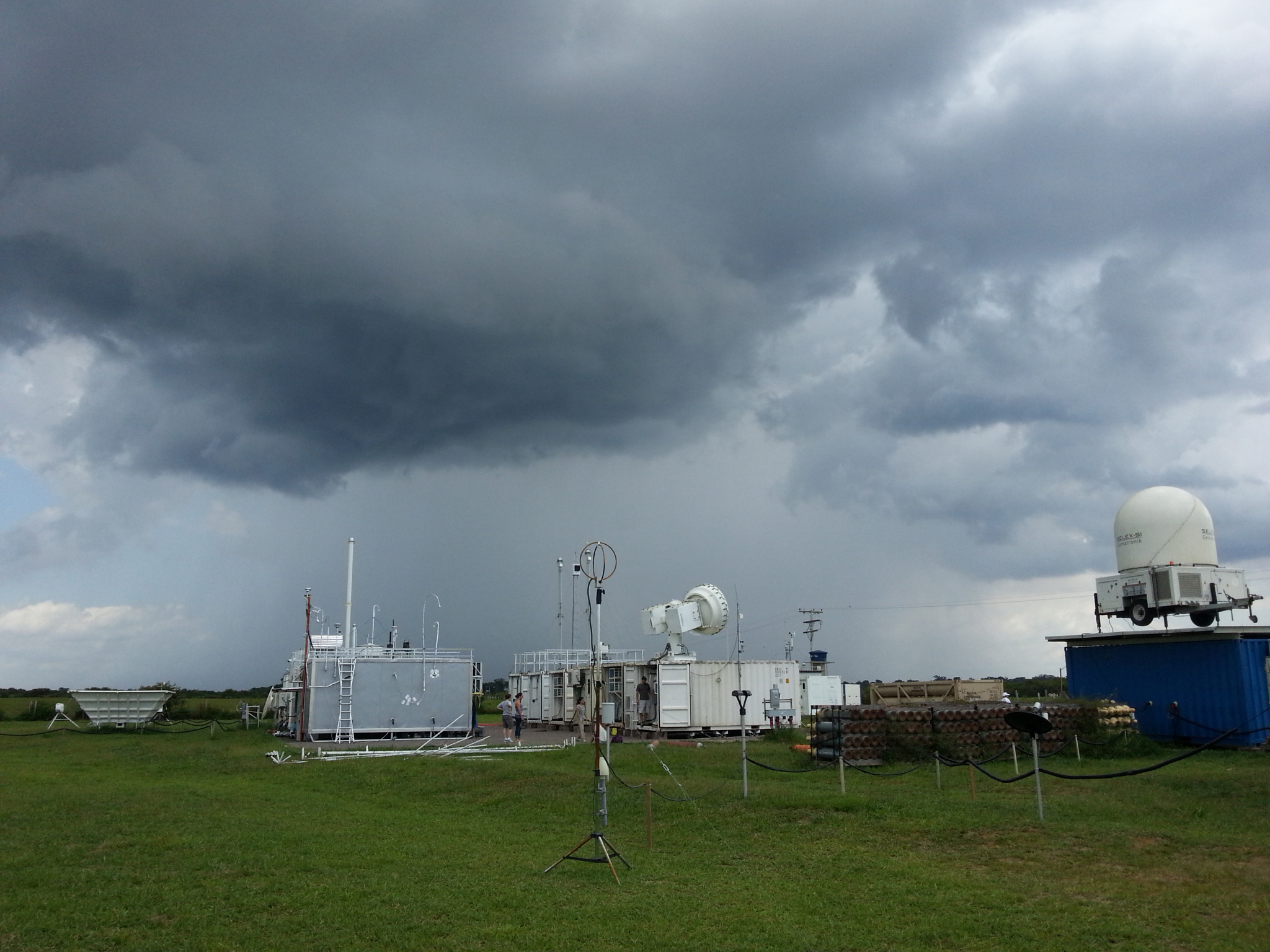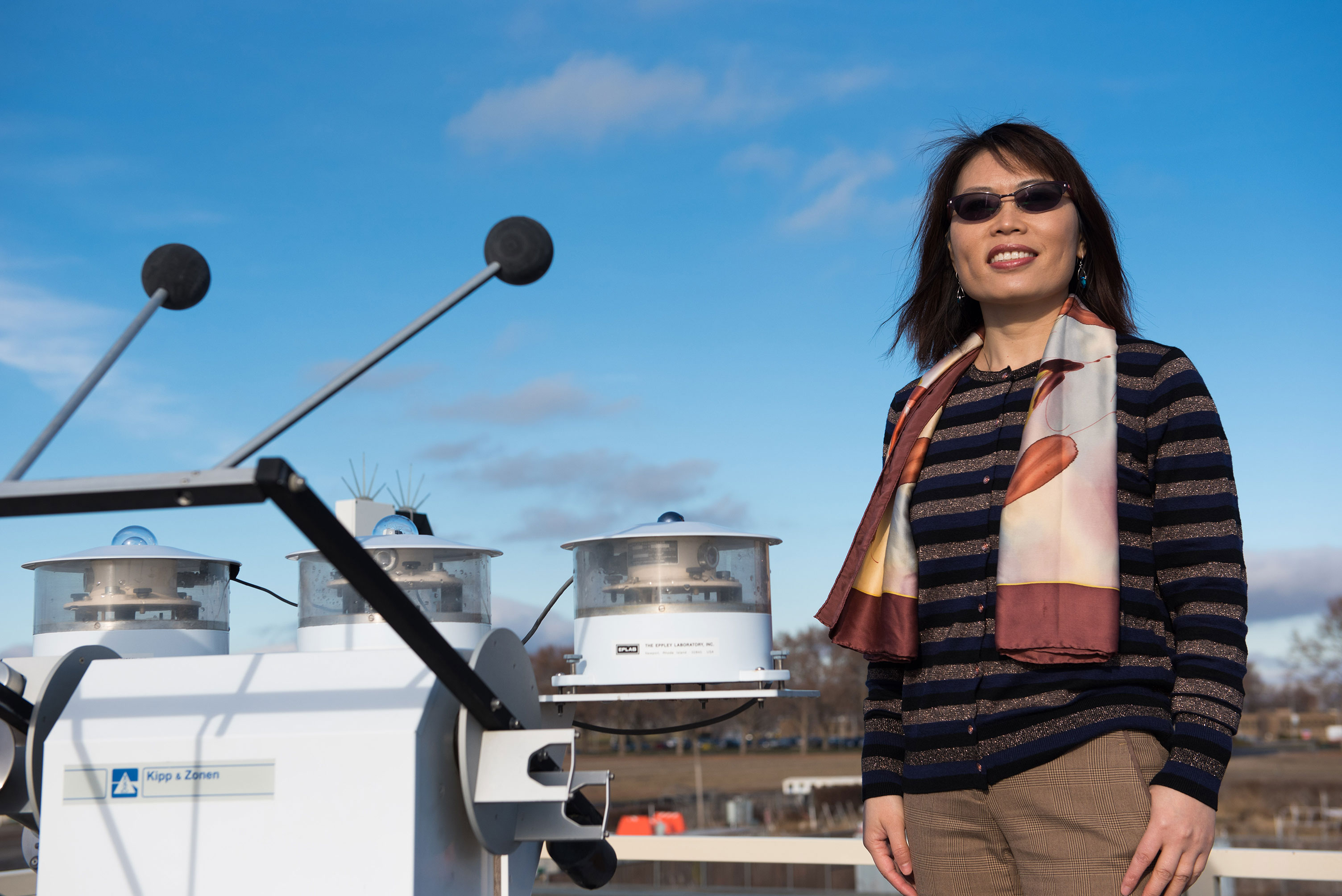Tiny Particles Have Outsize Impact on Storm Clouds and Precipitation
Special Stories
13 Feb 2018 9:13 AM
[Research aircraft outfitted with aerosol probes and sensors obtained data from the sky above Manaus during the GoAmazon research campaign. Credit: U.S. Department of Energy ARM Climate Research Facility]
From Pacific Northwest National Laboratory
Tiny particles fuel powerful storms and influence weather much more than has been appreciated, according to a recent study in the journal Science. The research focuses on the power of minute airborne particles known as aerosols, which can come from urban and industrial air pollution, wildfires and other sources. While scientists have known that aerosols may play an important role in shaping weather and climate, the new study shows that the smallest of particles have an outsize effect: Particles smaller than one-thousandth the width of a human hair can cause storms to intensify, clouds to grow and more rain to fall.
The tiny pollutants — long considered too small to have much impact on droplet formation — are, in effect, diminutive downpour-makers. "We showed that the presence of these particles is one reason why some storms become so strong and produce so much rain. In a warm and humid area where atmospheric conditions are otherwise very clean, the intrusion of very small particles can make quite an impact," said Jiwen Fan of the Department of Energy's Pacific Northwest National Laboratory, who is lead author of the paper in Science. Fan led 21 authors from 15 institutions around the world to do the study.
https://www.youtube.com/watch?v=IXIq8cUowxI
The findings are based largely on unique data made possible by the GoAmazon research campaign, where scientists made ground-based and airborne measurements related to climate during 2014-2015. The campaign was run by the Atmospheric Radiation Measurement (ARM) Climate Research Facility, a DOE Office of Science user facility.
The study capitalized on data from an area of the Amazon that is pristine except for the region around Manaus, the largest city in the Amazon, with a population of more than 2 million people. The setting gave scientists the rare opportunity to look at the impact of pollution on atmospheric processes in a largely pre-industrial environment and pinpoint the effects of the particles apart from other factors such as temperature and humidity.
 [A heavily instrumented ground site downwind of Manaus captured measurements of aerosols, clouds, and solar and thermal energy during GoAmazon. Credit: U.S. Department of Energy ARM Climate Research Facility]
In this study, scientists studied the role of ultrafine particles less than 50 nanometers wide in the development of thunderstorms. Similar but larger particles are known to play a role in feeding powerful, fast-moving updrafts of air from the land surface to the atmosphere, creating the clouds that play a central role in the formation of water droplets that fall as rain.
But scientists had not observed — until now — that smaller particles below 50 nanometers, such as particles produced by vehicles and industrial processes, could do the same. Not only that. The new study revealed that these particles, whose effects on clouds have been mostly neglected until now, can invigorate clouds in a much more powerful way than their larger counterparts.
[A heavily instrumented ground site downwind of Manaus captured measurements of aerosols, clouds, and solar and thermal energy during GoAmazon. Credit: U.S. Department of Energy ARM Climate Research Facility]
In this study, scientists studied the role of ultrafine particles less than 50 nanometers wide in the development of thunderstorms. Similar but larger particles are known to play a role in feeding powerful, fast-moving updrafts of air from the land surface to the atmosphere, creating the clouds that play a central role in the formation of water droplets that fall as rain.
But scientists had not observed — until now — that smaller particles below 50 nanometers, such as particles produced by vehicles and industrial processes, could do the same. Not only that. The new study revealed that these particles, whose effects on clouds have been mostly neglected until now, can invigorate clouds in a much more powerful way than their larger counterparts.
 [This photo shows the types of storm clouds that Jiwen Fan and colleagues studied as part of their study published in Science. Credit: Montanus Photography]
Through detailed computer simulations, the scientists showed how the smaller particles have a powerful impact on storm clouds. It turns out that when larger particles aren't present high in a warm and humid environment, it spells opportunity for the smaller particles to act and form cloud droplets. The low concentration of large particles contributes to high levels of excessive water vapor, with relative humidity that can go well beyond 100 percent. That's a key condition spurring ultrafine particles to transform into cloud droplets.
While the particles are small in size, they are large in number, and they can form many small droplets on which the excess water vapor condenses. That enhanced condensation releases more heat, and that heat makes the updrafts much more powerful: More warm air is pulled into the clouds, pulling more droplets aloft and producing more ice and snow pellets, lightning, and rain.
[This photo shows the types of storm clouds that Jiwen Fan and colleagues studied as part of their study published in Science. Credit: Montanus Photography]
Through detailed computer simulations, the scientists showed how the smaller particles have a powerful impact on storm clouds. It turns out that when larger particles aren't present high in a warm and humid environment, it spells opportunity for the smaller particles to act and form cloud droplets. The low concentration of large particles contributes to high levels of excessive water vapor, with relative humidity that can go well beyond 100 percent. That's a key condition spurring ultrafine particles to transform into cloud droplets.
While the particles are small in size, they are large in number, and they can form many small droplets on which the excess water vapor condenses. That enhanced condensation releases more heat, and that heat makes the updrafts much more powerful: More warm air is pulled into the clouds, pulling more droplets aloft and producing more ice and snow pellets, lightning, and rain.
 [Jiwen Fan, PNNL atmospheric scientist, led the study showing how tiny particles fuel large storms in the Amazon. Credit: Andrea Starr/PNNL]
The result: "Invigorated convection," as Fan says — and stronger storms. "We've shown that under clean and humid conditions, like those that exist over the ocean and some land in the tropics, tiny aerosols have a big impact on weather and climate and can intensify storms a great deal," said Fan, an expert on the effects of pollution on storms and weather. "More broadly, the results suggest that from pre-industrial to the present day, human activity possibly may have changed storms in these regions in powerful ways."
Edited for WeatherNation by Meteorologist Mace Michaels
[Jiwen Fan, PNNL atmospheric scientist, led the study showing how tiny particles fuel large storms in the Amazon. Credit: Andrea Starr/PNNL]
The result: "Invigorated convection," as Fan says — and stronger storms. "We've shown that under clean and humid conditions, like those that exist over the ocean and some land in the tropics, tiny aerosols have a big impact on weather and climate and can intensify storms a great deal," said Fan, an expert on the effects of pollution on storms and weather. "More broadly, the results suggest that from pre-industrial to the present day, human activity possibly may have changed storms in these regions in powerful ways."
Edited for WeatherNation by Meteorologist Mace Michaels
 [A heavily instrumented ground site downwind of Manaus captured measurements of aerosols, clouds, and solar and thermal energy during GoAmazon. Credit: U.S. Department of Energy ARM Climate Research Facility]
In this study, scientists studied the role of ultrafine particles less than 50 nanometers wide in the development of thunderstorms. Similar but larger particles are known to play a role in feeding powerful, fast-moving updrafts of air from the land surface to the atmosphere, creating the clouds that play a central role in the formation of water droplets that fall as rain.
But scientists had not observed — until now — that smaller particles below 50 nanometers, such as particles produced by vehicles and industrial processes, could do the same. Not only that. The new study revealed that these particles, whose effects on clouds have been mostly neglected until now, can invigorate clouds in a much more powerful way than their larger counterparts.
[A heavily instrumented ground site downwind of Manaus captured measurements of aerosols, clouds, and solar and thermal energy during GoAmazon. Credit: U.S. Department of Energy ARM Climate Research Facility]
In this study, scientists studied the role of ultrafine particles less than 50 nanometers wide in the development of thunderstorms. Similar but larger particles are known to play a role in feeding powerful, fast-moving updrafts of air from the land surface to the atmosphere, creating the clouds that play a central role in the formation of water droplets that fall as rain.
But scientists had not observed — until now — that smaller particles below 50 nanometers, such as particles produced by vehicles and industrial processes, could do the same. Not only that. The new study revealed that these particles, whose effects on clouds have been mostly neglected until now, can invigorate clouds in a much more powerful way than their larger counterparts.
 [This photo shows the types of storm clouds that Jiwen Fan and colleagues studied as part of their study published in Science. Credit: Montanus Photography]
Through detailed computer simulations, the scientists showed how the smaller particles have a powerful impact on storm clouds. It turns out that when larger particles aren't present high in a warm and humid environment, it spells opportunity for the smaller particles to act and form cloud droplets. The low concentration of large particles contributes to high levels of excessive water vapor, with relative humidity that can go well beyond 100 percent. That's a key condition spurring ultrafine particles to transform into cloud droplets.
While the particles are small in size, they are large in number, and they can form many small droplets on which the excess water vapor condenses. That enhanced condensation releases more heat, and that heat makes the updrafts much more powerful: More warm air is pulled into the clouds, pulling more droplets aloft and producing more ice and snow pellets, lightning, and rain.
[This photo shows the types of storm clouds that Jiwen Fan and colleagues studied as part of their study published in Science. Credit: Montanus Photography]
Through detailed computer simulations, the scientists showed how the smaller particles have a powerful impact on storm clouds. It turns out that when larger particles aren't present high in a warm and humid environment, it spells opportunity for the smaller particles to act and form cloud droplets. The low concentration of large particles contributes to high levels of excessive water vapor, with relative humidity that can go well beyond 100 percent. That's a key condition spurring ultrafine particles to transform into cloud droplets.
While the particles are small in size, they are large in number, and they can form many small droplets on which the excess water vapor condenses. That enhanced condensation releases more heat, and that heat makes the updrafts much more powerful: More warm air is pulled into the clouds, pulling more droplets aloft and producing more ice and snow pellets, lightning, and rain.
 [Jiwen Fan, PNNL atmospheric scientist, led the study showing how tiny particles fuel large storms in the Amazon. Credit: Andrea Starr/PNNL]
The result: "Invigorated convection," as Fan says — and stronger storms. "We've shown that under clean and humid conditions, like those that exist over the ocean and some land in the tropics, tiny aerosols have a big impact on weather and climate and can intensify storms a great deal," said Fan, an expert on the effects of pollution on storms and weather. "More broadly, the results suggest that from pre-industrial to the present day, human activity possibly may have changed storms in these regions in powerful ways."
Edited for WeatherNation by Meteorologist Mace Michaels
[Jiwen Fan, PNNL atmospheric scientist, led the study showing how tiny particles fuel large storms in the Amazon. Credit: Andrea Starr/PNNL]
The result: "Invigorated convection," as Fan says — and stronger storms. "We've shown that under clean and humid conditions, like those that exist over the ocean and some land in the tropics, tiny aerosols have a big impact on weather and climate and can intensify storms a great deal," said Fan, an expert on the effects of pollution on storms and weather. "More broadly, the results suggest that from pre-industrial to the present day, human activity possibly may have changed storms in these regions in powerful ways."
Edited for WeatherNation by Meteorologist Mace MichaelsAll Weather News
More